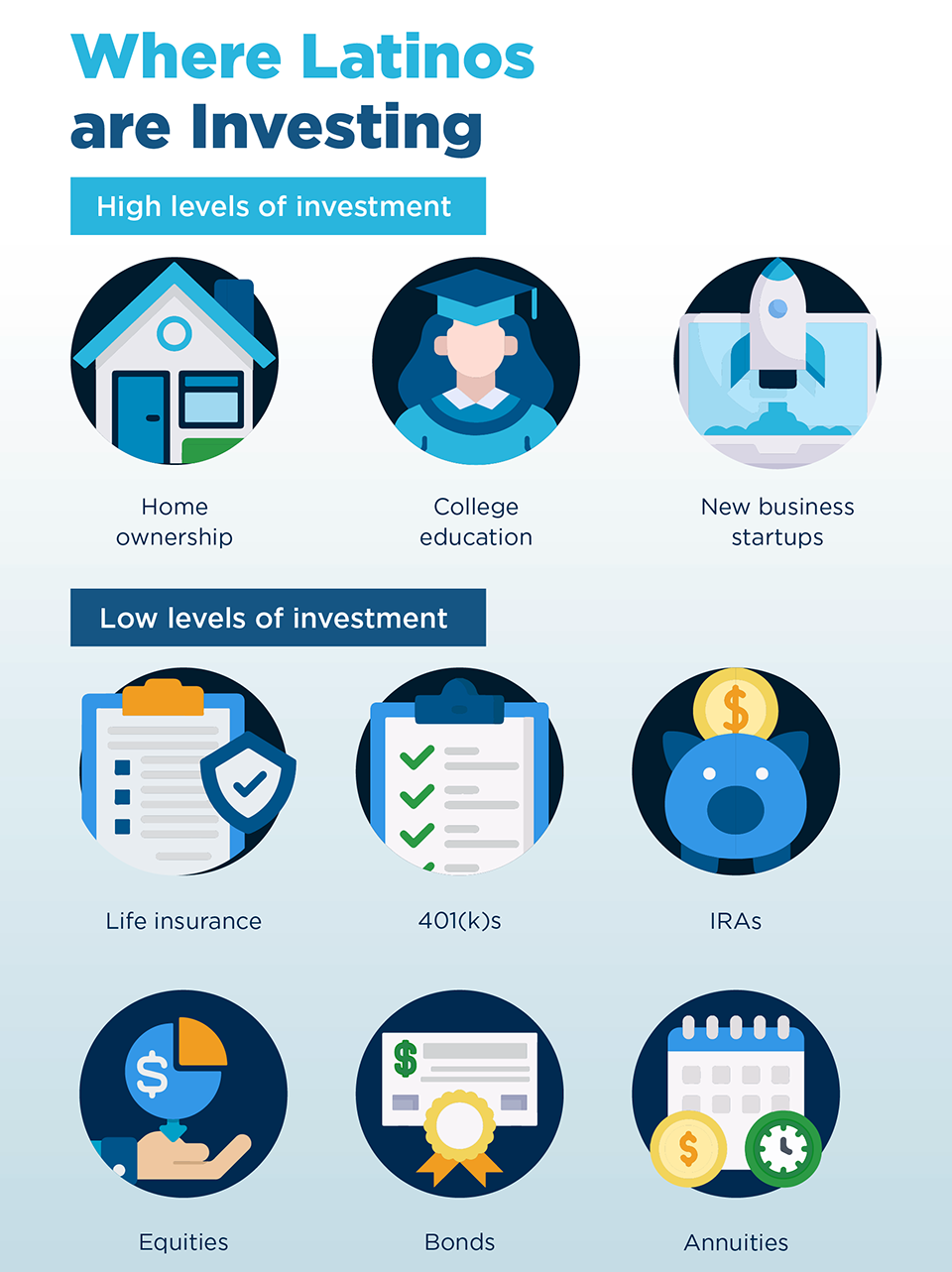For U.S. Latinos, investing begins at home
The Latino population of the United States is large, growing, and very diverse, hailing from more than 21 countries and made up of residents who range from recent immigrants to people whose families have been here for generations. This diversity extends to wealth as well, notes a 2021 McKinsey & Company study of the economic state of Latinos in America, which found that the median wealth of Latino families was just $38,000 in 2019, compared to $188,200 held by non-Latino white Americans.1
However, new research from Merrill reveals significant wealth gains for Latinos, with the size of the segment with annual household income over $125,000 increasing by around 81%, compared to 53% for the general population between 2014 and 2019.2
Even more recent findings from research firm Ipsos confirm that Latinos are on an upwardly mobile track. Focused on the rising number of “influyentes,” or the Latino Gen Zers who constitute 20% of all affluent Americans, the report found that affluent Latinos represent the largest affluent subgroup in the United States.3
Regardless of financial status, however, there are several constants that cut across countries of origin and dates of arrival. These are a focus on homeownership, a quest for education, and a penchant for entrepreneurship. And these constants, combined with the scale and scope of the U.S. Latino population, present an extraordinary opportunity for financial professionals—both Latino and not—looking to expand their client base.
“Latinos are highly intentional when it comes to making and saving money to invest in real estate,” says J. Alberto Lemus, managing partner of a Los Angeles-based firm that invests in real estate and infrastructure. Reflecting on his own experience as the son of Mexican immigrants who arrived in the United States in 1964, he notes that “They get there by working hard and hustling, which routinely involves taking a second job, doing a side gig, or starting a small business.”
This “unwavering commitment to homeownership attainment” was borne out in the 2021 State of Hispanic Homeownership Report from The National Association of Hispanic Real Estate Professionals (NAHREP)4 which showed that following the Great Recession, Latinos were the first demographic group to increase its homeownership rate, accounting for 78.5% of homeownership growth between 2011 and 2017. Since 2014, the first year of positive homeownership growth following the Great Recession, Latinos added a net total of 1.9 million owner households. This figure includes 657,000 owner households between 2019 and 2021, for an overall ownership rate of 48.4% that is projected to reach 50% by 2025.
A focus on college—and higher incomes
Saving for educational expenses is another high priority. “Latinos tend to have large families that live together in the same household,” Lemus says. “Keeping the family intact and ensuring that all the children attend college is paramount.”
For Latinos, as the NAHREP report shows, college attainment correlates with higher household incomes. To keep this connection growing, the report says, Latinos tend to earmark savings for education, allowing their children to graduate with lower student loan debt than do either non-Hispanic white households or Black households. And this, the report emphasized, puts these college graduates in a more favorable homebuying position at an earlier age. Moreover, the Ipsos research noted, as more Hispanics earn four-year college degrees, “the percentage of affluent [Latinos] would only increase in size over time,” putting more Latinos on a path to “attain economic power and break into the ranks of the top earning U.S. households.”
Building on a penchant for entrepreneurship
The emphasis on savings requires a clear-eyed focus on earning the money to save. And this, notes the McKinsey & Company study, is tied to the “very high rate of Latino entrepreneurship.” Latinos, the report found, “start more businesses per capita than any other racial or ethnic group in the United States” at “double the rate of white-owned employer firms over the past five years.”
However, notes Lemus, while “Latinos do not need to be educated on the importance of savings, and their supporting entrepreneurship and small business formation are major drivers of the economy, it is a matter of using better solutions to help grow and protect the money.” Reinforcing that point, he adds that “U.S. Latinos significantly oversubscribe on investing in real estate and heavily undersubscribe to all other asset classes. As a result, the participation of Latinos in 401(k)s, life insurance, equities, bonds, and other traditional wealth-building vehicles is disproportionately low.” For some Latinos, noted CNBC in a December 2021 report, this may be because more than two-thirds of their households lack employer-sponsored plans, only 8%have an IRA or similar plan, and more than 12% of Hispanic households do not have bank accounts.5
Access to credit and funding are also inhibiting factors. Despite continuing to outpace all other groups in terms of new U.S. business formation, Latino entrepreneurs significantly lag their white counterparts when it comes to company size and revenue. According to the 2019 State of Latino Entrepreneurship report from the Stanford Latino Entrepreneurship Initiative, Latino-owned businesses average $1.2 million in revenue.6 At only 52% of the $2.3 million average at white-owned concerns, Latinos consequently encounter funding shortfalls and other credit and financing challenges, including being steered toward higher-cost, riskier loans. As the Stanford report reveals, this has driven Latinos away from larger banks and loan institutions and more toward local and community banks, or friends and family for their capital needs.
The good news, however, as the McKinsey report concluded, is that “Addressing the barriers preventing Latinos from full economic participation could have a multi-trillion-dollar impact, further unleashing their entrepreneurial spirit, creating millions of jobs, driving consumer spending, and building intergenerational wealth.”
Growing tomorrow’s client base, today
And it is this point, as well as a combination of all these factors, Lemus and others note, that provides an excellent opportunity for financial advisors looking to serve the Latino market.
Lemus points to an additional fact that makes the Latino population a client base worth wooing. With a median age of 30—14 years younger than the non-Hispanic white population and the youngest of any ethnic or racial cohort group in the nation—Latinos are in prime lifecycle position. For financial professionals, he notes, “this is an ideal time to start a conversation about the right mix and ratio of asset classes that can help Latinos do more with their money. It is happening now, but the real wow will happen around 2040, when this generation reaches retirement age. I foresee a dramatically different landscape ahead for Latino investors. For firms that want to thrive in this market, it’s a long-term proposition that starts today.”
Keep in Mind
- U.S. Latinos save diligently for homeownership, but not retirement
- Spending priorities include education and supporting family members in the U.S. and back home
- Few participate in traditional wealth-building vehicles such as 401(k)s, life insurance, equities, and bonds
- U.S Latinos tend to avoid institutional lenders because of higher costs and risk
- They are more likely to turn to family and friends for loans and financial advice
One way to protect the ahorritos asegurado—the nest egg
Hispanics often choose saving vehicles that are familiar to them or are very conservative. For some that actually means saving all their money under a mattress or in a “marranito” (piggy bank). More often, though, they choose a conservative product such as a savings account or a certificate of deposit (CD) with a relatively low interest rate that provides them with the security of knowing their savings are immune to market volatility.
Behind this caution is the fact that many Hispanics do not trust the U.S. financial industry and most of them are understandably concerned with protecting their ahorritos asegurado, their nest egg.
But there are ways to provide your Hispanic clients with both peace of mind and a better return. Once you’ve taken the time to understand both their culture and their individual concerns, you could, for example, introduce the concept of a fixed annuity, with its benefits of guaranteed growth and tax deferral. Depending on the product, clients may also get a death benefit, access to the account value if needed, and even lifetime income they cannot outlive.
Share
Related resources
More on Multicultural Markets
Your Thriving
Practice
A destination to empower financial professionals to build, manage, and grow their practice
Get started with Global Atlantic
Take the next step with a company that can help elevate your business.
Need help?
Find all the contact information to submit and service your business.











